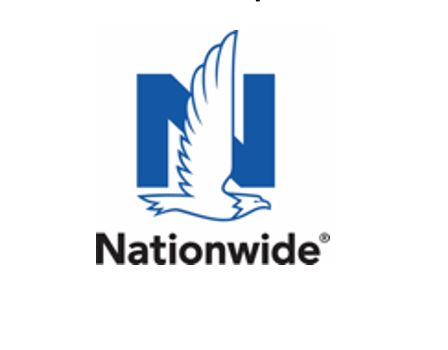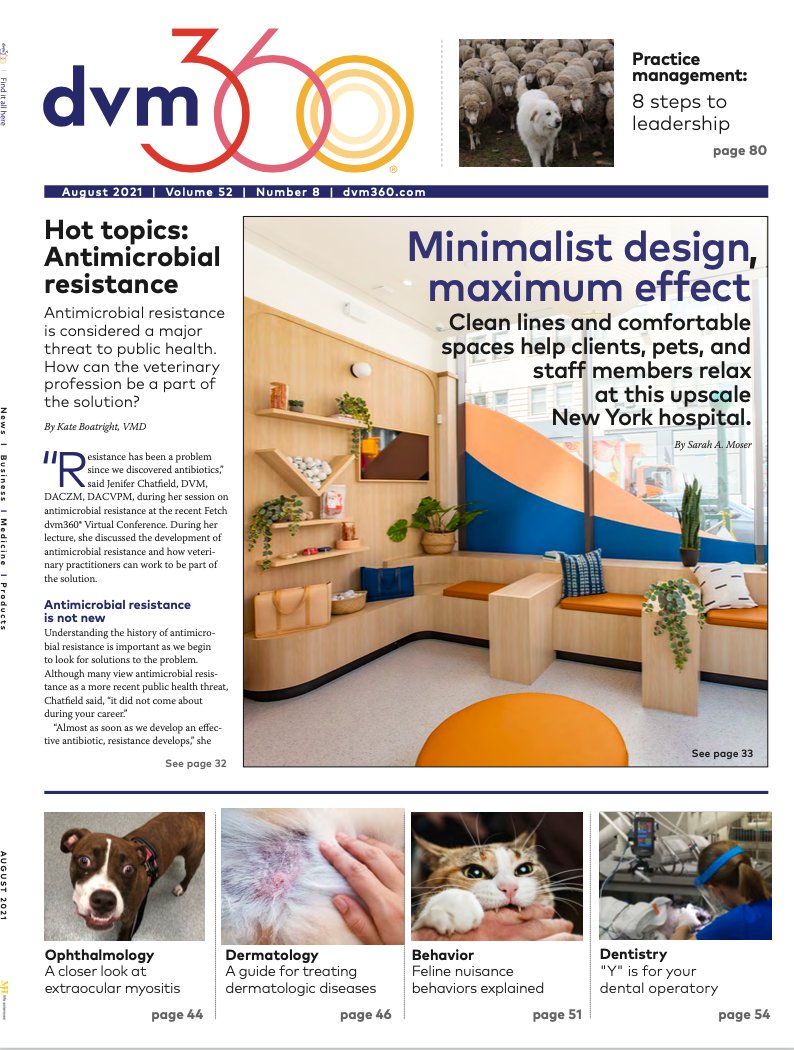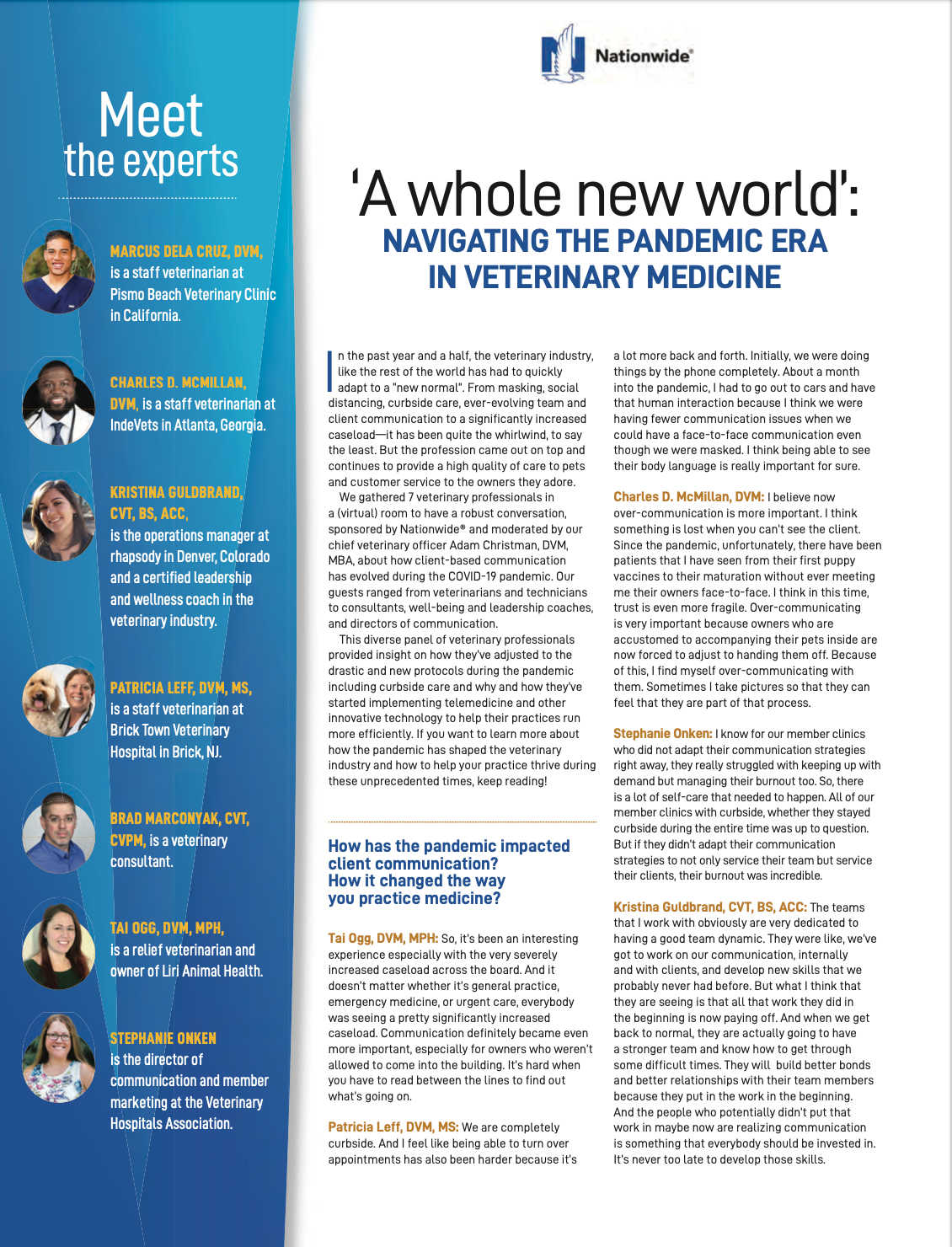A whole new world’: Navigating the pandemic era in veterinary medicine
Seven veterinary professionals share how client communication has evolved during the COVID-19 pandemic. (Sponsored by Nationwide)
In the past year and a half, the veterinary industry, like the rest of the world has had to quickly adapt to a “new normal”. From masking, social distancing, curbside care, ever-evolving team, and client communication to a significantly increased caseload—it has been quite the whirlwind, to say the least. But the profession came out on top and continues to provide a high quality of care to pets and customer service to the owners they adore.
We gathered 7 veterinary professionals in a (virtual) room to have a robust conversation, sponsored by Nationwide® and moderated by our chief veterinary officer Adam Christman, DVM, MBA, about how client-based communication has evolved during the COVID-19 pandemic. Our guests ranged from veterinarians and technicians to consultants, well-being and leadership coaches, and directors of communication.
This diverse panel of veterinary professionals provided insight on how they’ve adjusted to the drastic and new protocols during the pandemic including curbside care and why and how they’ve started implementing telemedicine and other innovative technology to help their practices run more efficiently. If you want to learn more about how the pandemic has shaped the veterinary industry and how to help your practice thrive during these unprecedented times, keep reading!
How has the pandemic impacted client communication? How it changed the way you practice medicine?
Tai Ogg, DVM, MPH: So, it’s been an interesting experience especially with the very severely increased caseload across the board. And it doesn’t matter whether it’s general practice, emergency medicine, or urgent care, everybody was seeing a pretty significantly increased caseload. Communication definitely became even more important, especially for owners who weren’t allowed to come into the building. It’s hard when you have to read between the lines to find out what’s going on.
Patricia Leff, DVM, MS: We are completely curbside. And I feel like being able to turn over appointments has also been harder because it’s a lot more back and forth. Initially, we were doing things by the phone completely. About a month into the pandemic, I had to go out to cars and have that human interaction because I think we were having fewer communication issues when we could have a face-to-face communication even though we were masked. I think being able to see their body language is really important for sure.
Charles D. McMillan, DVM: I believe now over-communication is more important. I think something is lost when you can’t see the client. Since the pandemic, unfortunately, there have been patients that I have seen from their first puppy vaccines to their maturation without ever meeting me their owners face-to-face. I think in this time, trust is even more fragile. Over-communicating is very important because owners who are accustomed to accompanying their pets inside are now forced to adjust to handing them off. Because of this, I find myself over-communicating with them. Sometimes I take pictures so that they can feel that they are part of that process.
Stephanie Onken: I know for our member clinics who did not adapt their communication strategies right away, they really struggled with keeping up with demand but managing their burnout too. So, there is a lot of self-care that needed to happen. All of our member clinics with curbside, whether they stayed curbside during the entire time was up to question. But if they didn’t adapt their communication strategies to not only service their team but service their clients, their burnout was incredible.
Kristina Guldbrand, CVT, BS, ACC: The teams that I work with obviously are very dedicated to having a good team dynamic. They were like, we’ve got to work on our communication, internally and with clients, and develop new skills that we probably never had before. But what I think that they are seeing is that all that work they did in the beginning is now paying off. And when we get back to normal, they are actually going to have a stronger team and know how to get through some difficult times. They will build better bonds and better relationships with their team members because they put in the work in the beginning. And the people who potentially didn’t put that work in maybe now are realizing communication is something that everybody should be invested in. It’s never too late to develop those skills.
Brad Marconyak, CVT, CVPM: What I’m finding out is that not only are they [teams] having to communicate with the clients on the phone, but staff communication internally has become more challenging with people running around. In the beginning, so many clinics were doing shift work because if somebody got potentially exposed, they didn’t want to have to close the clinic. So, they were running half teams. And ironically, probably 6 months into it, many hospitals were talking about how they found out who their true strong team members were, and how they can truly run efficiently because they’ve started communicating better.
What are some workflow barriers that your hospital/ team has experienced? How did you combat them?
Onken: So the VHA being an association, we had the opportunity to be nimble and support our members when they were running around like chickens with their heads cut off, trying to protect themselves and their families, and their teams, and their patients. We reached out and partnered with companies like PawsTime, like Virtuwoof, like PetPro Connect, and really brought these technologies to the clinic and said, “Hey, we’ve done the research, we’ve done the vetting, we’ve got you a discount. Use this, and here’s how we’re going to help you utilize it.” One of the biggest complaints we’ve heard from our members was that they couldn’t keep up with the phone calls. Their phone lines were ringing off the hook.
Guldbrand: From the software side, one of the things I love about the PIMS software
we work with is that we created a kiosk that people can fill out through a link online, so people could fill out their intake form from a link that they get texted to their phone. And during the pandemic, we really pushed hard to make sure we gave them as many features, like universal inbox. So the office can text the client from their patient chart, and the client can email them back if they want to, and kind of creating that ease of communication.
Ogg: I have definitely seen practices where maybe they weren’t utilizing staff quite
to their full potential. But now because of curbside, if you’re not efficient you just can’t make it through the day. They have started to push their staff to fill certain roles, whether they’re assigned to a certain task for the day, or however it works, and it’s nice to see more hospitals actually utilizing their staff. I think it makes the staff a lot happier, it makes them feel like they’re a lot less burned out.
Marcus Dela Cruz, DVM: So one thing that our hospital did that I thought was really cool —and we’re seeing more—is using QR codes. So in California, there’s a law that every drug that is sent home that’s an oral medication, the client has to be asked if they would like a consult on it, decline it, or accept it. And if they want a consult, basically what we’ve done is we put the QR code on the bottle that we send it home so that they can scan it. It links directly to a Plumb’s link that has all the adverse events listed of that drug. That’s been kind of cool. It’s something I never thought I would see, but the pandemic has really forced us into it. During my initial couple of months, my mentor was like, “You are terrible on the phone. You’re flat. It doesn’t come across. Every client you call thinks that their dog’s going to die because you’re just so flat.” So this whole transition has been really a big game changer for me.
Are you seeing a greater conversation of “I wish I had the money and am worried I have to put my pet down?"
McMillan: I work for a staffing company as a regular relief vet now. I work in multiple environments. I haven’t appreciated an uptick or a change in the dynamic of the conversation of euthanasia. Many hospitals that I visit have made special exceptions and accommodations for people who feel the need that euthanasia was the best option such as allowing them to come inside and trying to make them feel as comfortable as possible. The pandemic has affected many people and many groups of people differently. Fortunately, when clients drop their pets off to see me there is usually something that can be done for their pet even if financial limitations do not allow for the gold standard.
Leff: Fortunately, we’re not seeing more concern for euthanasia, either. We’re working with clients, doing treatment plans, offering care credit, trying to break up treatment plans if we can do they can do a little here and then a little next week if that’s the way the owner chooses to do things.
Dela Cruz: Our community is an older community, so a lot of people have retired already, so they weren’t kicked out of a job or lost their job. They’re on fixed incomes, and so we really haven’t seen an uptick in euthanasia or in the ability to afford services. But I didn’t know if that was special because of our community specifically or if that’s kind of across the board, so that’s really interesting to hear.
Onken: We did see an uptick. Because we offer cremation, our numbers thankfully didn’t increase throughout the pandemic abnormally. So that means our veterinarians were not offering economic or convenience euthanasia. One of my clients is actually an at-home euthanasia clinic, and she has blatantly across her website—videos, social media, across everything—do not contact her for convenience euthanasia.
Leff: We’ve been able to rehome some patients with owners who felt they could
no longer care for them because people are looking to bring in fur babies into their homes. And so we’re lucky enough to have a couple of rescues in the area that we work with. A couple of patients signed over to our hospital and we were able to find homes for them. If anything, I think spending actually is on the rise at our clinic.
About Nationwide pet insurance
With more than 1 million insured pets, pet insurance from Nationwide is the first and largest pet health insurance provider in the United States. Since 1982, Nationwide has helped provide pet owners with peace of mind and is committed to being the trusted choice of America’s pet lovers.
Nationwide plans cover dogs, cats, birds, and exotic pets for multiple medical problems and conditions relating to accidents, illnesses, and injuries. Medical plans are available in all 50 states and the District of Columbia.
Products underwritten by Veterinary Pet Insurance Company (CA), Columbus, Ohio; National Casualty Company (all other states), Columbus, Ohio. Agency of Record: DVM Insurance Agency. All are subsidiaries of Nationwide Mutual Insurance Company. Nationwide, the Nationwide N and Eagle, and Nationwide is on your side are service marks of Nationwide Mutual Insurance Company. ©2021 Nationwide. Pet owners can find Nationwide pet insurance on Facebook or follow on Twitter. For more information about Nationwide pet insurance, call 800-672-9259 or go here.


2 Commerce Drive
Cranbury, NJ 08512
All rights reserved.
